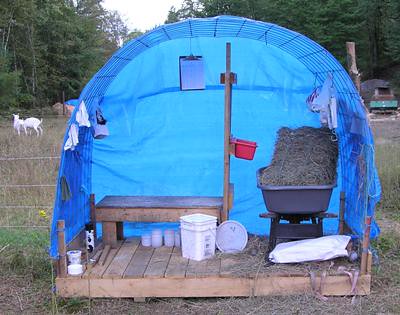We had a string of at least two weeks of good weather that spanned all the important days of kidding. Going into April, my wife pointed out that last year we had three
significant snow storms in
April. Not this year. We are completely melted out except the patch of snow on the north west corner that gets dumped on by both the house and the barn roofs. It is down from 8 feet to a foot and a half, soon to be gone. My mother in law looks to have won the pool on that, it will be gone before May.
The string of sunny days has been broken, though. It started raining at about 9 AM and has been going pretty steady ever since. The drainage over flow in the back yard is brimming.
That's where the whole backside of the house and two
thirds of the barn rain water ends up. We usually have two 55 gallon drums to catch it, but I haven't set that up yet this spring. Today's rain would have easily filled it.
We do have the spring line setup. When I bought this house the
main house was still supplied by the surface well in a cleft up above the house. It will gravity feed into the firs floor of the house. One of the conditions to buy the house was to put in a drilled well, the state frowns on surface water. So I dug a line from the spring to the garden and we now have a supply for the garden that is
separate from our drinking water.
We moved the greenhouses today. We had two greenhouses in the garden this year, one for the chickens and one for plants. During the coldest winter days, the plants go dormant since the greenhouse is unheated. But they are
that much further along when temperatures do allow. This year, we got a solid extra month of growth over unprotected ground in the garden. Most people in this area are just starting to talk about working their gardens, but my wife already has greens to harvest, radishes, leaks, etc. All cold hearty stuff to begin with, but we are already getting daily
salads out of the garden. So, today we took down the chicken green house and moved the plant greenhouse to a new set of beds. We also constructed two new raised beds in the garden to match the greenhouse foot print. The cold hearty stuff is ready to be out on its own and my wife will be moving tomatoes and peppers out to the new green house location. I am really impressed with the amount she already has growing in the garden. I'll try to put up some pictures when we takes some.
Out back, we are adding some new goat "pasture". Last year I put up a 75' square pasture for the goats and we tried to go rational grazing in that. But it was too small and we really weren't getting enough time between rotations. So I am adding another similar sized fenced area and then we will have two smaller pastures
in between the two permanently fenced ones. That will give us a four month
separation which is much better from a parasite perspective. Unfortunately, it is not optimal for forage nutrition, but the parasites are a more important consideration.
Labels: Cattle panel structure, CPS, Garden, greenhouse, plants, Stock panel, weather














































